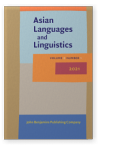Vol. 2:1 (2021) ► pp.36–79
The split word orders APV and PAV of Nuosu Yi
Comparing to the split ergativity of the Tibeto-Burman languages
Nuosu Yi is a Tibeto-Burman (henceforth TB) language lacking sufficient core case markers. Depending on the telicity and aspectuality of the predicates, its basic word order splits into APV and rigid PAV. To be specific, the atelic and/or imperfective predicates are APV, while the telic predicates indicated by the resultativity or perfect aspect are PAV. This paper describes the semantics and syntax of the syntactic PAV and APV of Nuosu Yi thoroughly; and compares them to other TB languages in terms of role marking strategies. I propose that the conditions of split word order in Nuosu Yi are on a par with those of the split ergativity encoded by the morphological marking in Tibetan and some other TB languages; namely, the rigid PAV corresponds to the ergative alignment, and the rigid APV corresponds to the accusative alignment. The study will deepen Nuosu Yi’s morpho-syntax study and show the word order diversity to the studies of linguistic typology. Additionally, the study sheds light on the possibility of extending the definition of ergativity and its potential counterpart.
Article outline
- 1.Introduction
- 2.The background and linguistic profiles of the Nuosu Yi Language
- 2.1Location and population
- 2.2Genetic classification and varieties
- 2.3The related typological profile
- 2.4Morphological case marking in Nuosu Yi
- 2.4.1Morphological marking for agentive case
- 2.4.2Morphological marking for oblique cases
- 2.4.3Distinction between nominative and accusative pronoun of the third singular person
- 2.5Split basic word order PAV and APV of Nuosu Yi
- 3.Lexical aspect and grammatical aspect of Nuosu Yi
- 3.1Situation types (lexical aspect) of verb phrases
- 3.1.1State situations of verb phrases
- 3.1.2Activity situations of verb phrases
- 3.1.3Achievement situations of verb phrases
- 3.1.4Accomplishment situations of verb phrases
- 3.2Grammatical aspectual marking
- 3.2.1Indicative particle o⁴⁴ functioning as perfective and inchoative
- 3.2.2Perfect or anterior marker ta³³
- 3.2.3Progressive and durative marker ndʑɔ³³
- 3.2.4Prospective aspect
- 3.2.4.1Prospective marker mi⁴⁴ and mi⁴⁴ta³³
- 3.2.4.2Volitive modality particles mo³³ and mo³³di⁴⁴
- 3.3Summary
- 3.1Situation types (lexical aspect) of verb phrases
- 4.Systematic description of the split word order in Nuosu Yi
- 4.1The semantic and syntactic conditions of PAV word order
- 4.1.1PAV used in the clauses with accomplishment-predicate
- 4.1.2PAV used in the clauses with achievement-predicate
- 4.1.3PAV used in the clauses with perfect aspect marker ta³³
- 4.2The semantic and syntactic conditions of APV word order
- 4.2.1APV used in the clauses with state predicates
- 4.2.2APV used in the imperfective event clauses with the progressive aspect
- 4.2.3APV used in the imperfective clauses with the modality and the illocutionary prospective
- 4.2.4APV used in the sentences with negations of achievements and perfect phrases
- 4.2.5APV used in the sentences which VPs end with a directional verb
- 4.3The word order of complex constructions
- 4.4Summary
- 4.1The semantic and syntactic conditions of PAV word order
- 5.Reviewing on the previous accounts for the syntactic alignment PAV in Nuosu Yi
- 5.1Interpreting the syntactic PAV as a passive structure
- 5.2Interpreting the syntactic PAV as a topic structure
- 6.Comparisons of the role-encoding within TB languages
- 6.1The patterns of semantic role marking of TB languages
- Pattern I: Languages using an obligatory agentive marker – ergative languages
- Pattern II: Languages using dsm for pragmatic purpose – optional ergativity
- Pattern III: Languages with dsm without ergativity – accusative languages
- Pattern IV: Languages with dom only
- Pattern V: Language with obligatory word order only – Nuosu Yi
- 6.2Summary
- 6.1The patterns of semantic role marking of TB languages
- 7.Conclusion and proposal
- Acknowledgements
- Notes
- Abbreviations
-
References
